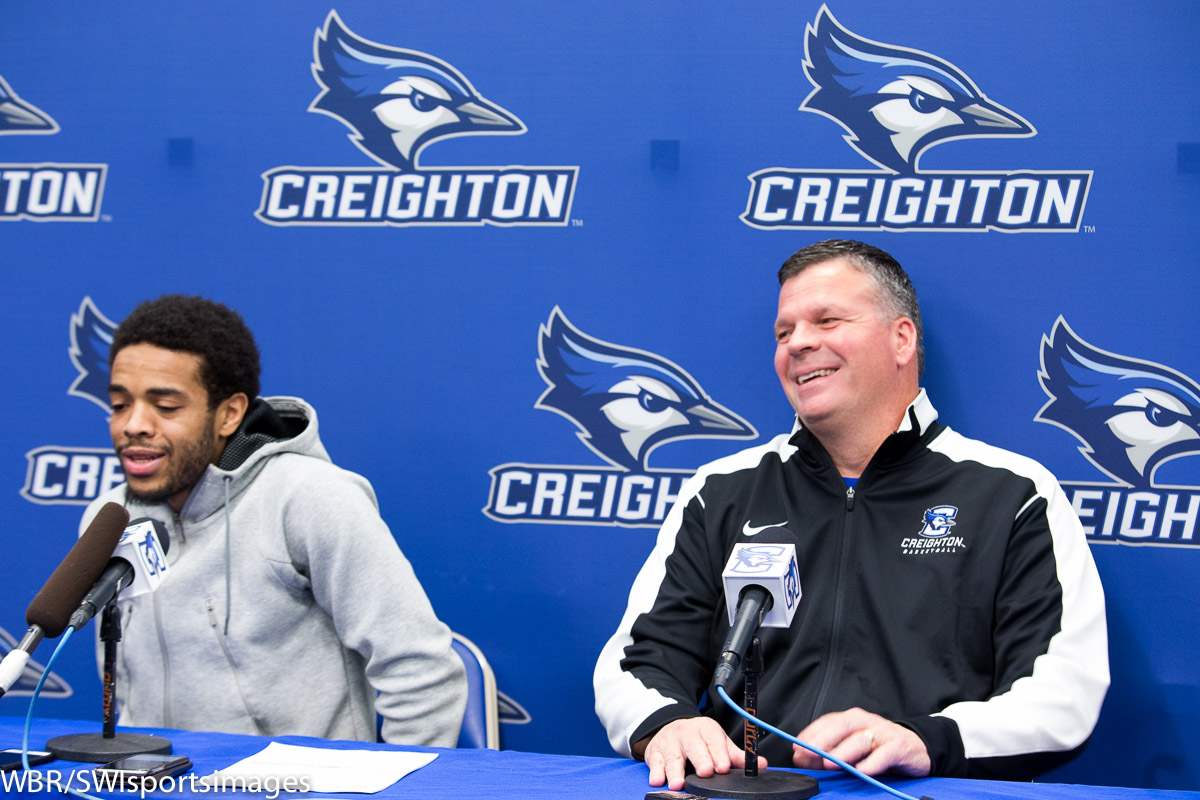College basketball teams that lose their point guard, especially one as good as Maurice Watson, Jr., can find the road forward to be a tough one. Creighton’s fans know all about it first-hand (don’t worry, this won’t be an analogy to a non-basketball sport or a non-Creighton team; there’s other media outlets around to do that.)
In 2003-04, the Bluejays blasted out to a 12-0 start, and were ranked 24th in the AP poll when junior point guard Tyler McKinney went down with an eye injury. McKinney had been averaging 3.9 assists per game at the time his season ended, and his loss left a veteran team without the player who’d piloted the previous two NCAA Tournament teams. That was a team full of experienced front court players, including four fifth-year seniors — Brody Deren and Michael Lindeman in their third year as starters, Mike Grimes and Joe Dabbert in their fourth year as key contributors — to surround the veteran McKinney and an otherwise young guard corps.
He was the player they could least likely afford to lose, and when he went down, a newcomer assumed the starting point guard role — junior college transfer Johnny Mathies. Their styles could not have been more different: McKinney was a true pass-first facilitator-style point guard, while Mathies’ slashing ability made him better suited to be an off-guard. And they were OK initially after the injury; on February 5 they were 15-2 and on the right side of the NCAA Tournament bubble. Then the bottom fell out, as they lost five of their next eight and were eliminated on the first day of the MVC Tournament by Southwest Missouri State. They wound up in the NIT, where they were eliminated by Nebraska on a last-second shot.
“Losing Tyler cut our rotation down to where I wasn’t playing enough people,” Altman told the Omaha World-Herald toward the end of that year. “You can’t press and run and do all the things we try to do and play 35 minutes. We were making guys play way too many minutes. I got a little conservative and didn’t play my freshmen like I should have. Cutting down the rotation made us lose some of our defensive intensity. Offensively, Tyler knows our system so well. We’re not as organized offensively as we were when he was playing. He has a command of our offense. Johnny’s trying and he has done a good job, but he has a lot to pick up.”
Mathies was a warrior and wound up as a huge contributor to an NCAA Tourney team the following year, but in 2004 he was a newcomer playing out of position because the team had no better options.
Two years later, they found themselves in the same boat. Mathies was now a senior, and came into the season planning to split time with freshman Josh Dotzler in the backcourt. Then Nate Funk went down with a shoulder injury in November, and Mathies shifted to getting most of his minutes at the two-guard while Dotzler played the majority of the minutes at the point. Dotzler had been terrific, averaging 4.4 assists and 2.2 steals a game, and was a big reason the Jays had gone 14-2 after the loss of Funk. They were 17-5, tied for first in the MVC, and in the running for an NCAA Tournament berth.
Then Southern Illinois came to town. Dotzler got tangled up with a Saluki defender while dribbling through their notoriously-physical full court defense, and suffered what wound up as a season-ending knee injury. Dana Altman was asked by the Omaha World-Herald after the injury what his Plan B was, and he replied, “I don’t think we have one. That’s why Josh has played all these minutes.”
It showed. They went 2-2 down the stretch, lost in the first game of the MVC Tournament 54-47 to Bradley and found themselves in the NIT during a year when the Valley sent four teams dancing.
Both of those squads never fully recovered from the loss of their starting point guard, and once-promising seasons wound up with NIT berths. The good news is that while Watson is a better point guard than either McKinney or Dotzler (and thus his loss is more painful), the rest of the roster is in a lot better shape.
The 2003-04 team had lost guards Kyle Korver, DeAnthony Bowden and Larry House from the previous year, and when McKinney was lost, they struggled to adapt because they no longer had a point guard that could make the post-entry passes needed to take advantage of their talented frontcourt. They averaged just 66.0 points per game after his season ended, after averaging 71.2 with him in the lineup.
The 2005-06 squad lost Dotzler so late in the season that they had no time to regroup, and they too struggled offensively without him — a team that had averaged almost 67 points with him had dropped to 59.2 without.
As the 2016-17 Bluejays look to move on from Maurice Watson, Jr., they have options and depth that neither of those Altman-Era squads had the luxury of. They could go with the veteran, Isaiah Zierden; the walk-on, Tyler Clement; the freshman, Davion Mintz; or a wild-card like Ronnie Harrell (who played point guard in high school).
Zierden offers a veteran presence who’s played enough in the Big East to not be rattled by whatever an opponent throws at him, and his basketball IQ and knowledge of Creighton’s schemes allows him to initiate offense effectively in the half-court. Defenses have to respect his shooting ability, which helps space the floor. He’s an adequate ball-handler who doesn’t turn it over. All of those things worked in his favor when he was pressed into emergency duty against Xavier, though with Zierden the Jays will have to play at a slower half-court pace.
His success at Xavier came against a team that hadn’t scouted or prepared for a Zierden-led Bluejay offense. Given time to watch film and prep a gameplan, teams will be far more likely to offer at least token pressure on the ball, if not run a full-on press to make him work (and perhaps force turnovers before the offense can even get set). And defensively, he’s a liability, especially against quick guards.
Clement has the advantage of serving as Watson’s de facto backup most of last year and the first part of this year, and for the most part is a serviceable point guard in a limited role — he’s a solid passer, he knows the offense well enough that you don’t have to pare down the playbook when he’s on the floor, and he has enough speed to push the pace a little (though not anywhere close to what Watson was capable of). He’s a decent shooter, but not good enough to make defenses respect his shot like they do Zierden’s, leaving less space for his teammates to operate. While teams will opt to press Zierden when he’s at point in an effort to tire him out, they’ll press Clement for another reason — forcing turnovers. He’s a lot of things, many of them very good, but he does have physical limitations and those have shown up in trying to break a press. Arizona State made him look completely overmatched in December by pressing him full court, and you can bet the film of that will make the rounds in Big East coaches’ rooms ASAP.
The presence of Mintz on the roster is where this Creighton team can better absorb the loss of their point guard compared to 2004 and 2006. He’s a player who was recruited as a point guard, and was expected to take over for Watson next year anyway (splitting time with Kaleb Joseph). Mintz also gives the Jays something Zierden and Clement don’t — the ability to create off the dribble, to get into the teeth of the defense, and to finish at the rim. He’s shown flashes of being able to conduct the Jays’ fast-paced offense at a clip similar to what Watson did, but he’s a true freshman. That means he’ll make mistakes. He’ll probably make passes that leave you scratching your head. He’ll likely make decisions that leave you groaning. He might get into foul trouble trying to defend opposing guards. But he offers upside the other two don’t; watching him slice through this double-team on Monday at Xavier and finishing at the rim is a great example:
The starter is going to be either Zierden or Mintz, and Clement will have a role backing them up. There will be a lot of experimentation, and all three will play the point in varying amounts. And there’s risk and reward to both choices; Zierden is the conservative, safe choice, but what you gain in security you give up in pace. Playing him 30+ minutes at point guard changes the rotation at three positions (the point and both wings, as Zierden had been the backup at both wing spots). And, his season has ended prematurely due to injury each of the last two years, so relying on him for heavy minutes at the point guard is risky.
Mintz is a riskier choice because he’s a true freshman, but what you give up in trust and security you gain in style of play and pace — going with Mintz as your primary point guard means you don’t have to change how you play. It also means you only upset your rotation at one spot, rather than three. There will be growing pains, but if ever there was a time to throw a freshman point guard to the wolves, this is it: home games with Marquette and DePaul sandwiched around a road game at a struggling Georgetown squad.
Losing their starting point guard spoiled NCAA Tournament seasons in 2003-04 and 2005-06, but that won’t be the case in 2016-17. Marcus Foster averages 18.1 points a game and is a better, more versatile scorer than any player on either of those teams, and remains one of the best pure scorers in the Big East. Khyri Thomas is still an effective secondary scorer, and one of the best lockdown defenders in the league. Cole Huff, Isaiah Zierden and Toby Hegner can still shoot the heck out of the basketball. Justin Patton is still a future NBA lottery pick big man. None of that has changed. And the options to take over for Watson (there’s no replacing him) are better, too — neither of those Altman-Era teams had the luxury of choosing between three good options as they moved forward.
If Davion Mintz can get up to speed over the final six weeks of the season so he’s fully ready to be the full-time point guard by the time the Big East Tourney rolls around, I don’t see any reason why Creighton’s goals — or ceiling — should be any different than they were before Watson went down.


